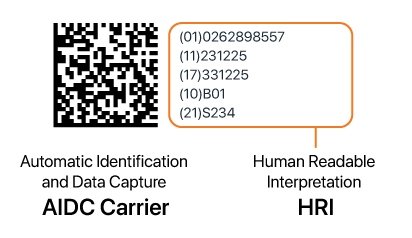You are here
UDI labelling for sponsors and manufacturers
The device label is to include a UDI carrier on the label or on the device itself and on all higher levels of device packaging.
The UDI carrier is not to replace any other existing labelling requirements that apply under the Therapeutic Goods Act or Medical Device Regulations.
The UDI carrier is to be in a human readable (Human Readable Interpretation, or HRI) and machine readable (Automatic Identification Data Capture, or AIDC) formats.
Both the AIDC and HRI must follow the rules of the chosen UDI Issuing Agency. The HRI is to be:
- a legible interpretation of the data characters encoded in the UDI Carrier
- usually presented next to or below the AIDC carrier.
UDI carrier placement is the manufacturer's responsibility. The placement of the UDI carrier should be done in a way that the AIDC can be accessed during normal operation or storage.
If there are significant constraints limiting the use of both AIDC and HRI on the label, the AIDC format shall be favoured. However, certain environments or use situations, such as home care, may warrant the use of HRI over AIDC.
An example of a label that shows both AIDC and HRI format:

An example of a UDI label incorporated into existing labelling:
Contact your Issuing Agency for UDI labelling guidance. The UDI Guidance documents will also provide more information.
Automatic Identification Data Capture (AIDC) technologies and machine-readable formats
We will not restrict the machine-readable form to a specific symbology, noting that some symbologies may be more appropriate for specific settings or use. For example, one-dimensional barcodes are more suited to supply chain use.
AIDC technology that may be used includes:
- linear barcodes (1D)
- matrix barcodes (2D)
- smart cards, biometrics
- Radio Frequency Identification (RFID).
If the manufacturer is using RFID technology, they must comply with open and commercially acceptable, international standards such as ISO 17366:2013. A linear, 2D barcode or another type of barcode must also be provided on the label to maintain usability for systems with varying technological capabilities.
UDI packaging level requirements
A UDI must be on all higher levels of device packaging (noting higher levels of packaging do not include shipping containers).
Secondary packages contain a set number of a base package of a device. Tertiary packages contain a set number of a secondary package of a device. A unique UDI-DI must be allocated to each set configuration of a device package, for example 6 devices, 4 cartons.
The AusUDID allows for the linking of all packaging levels to the UDI record.
European Union (EU) or United States (US) UDI compliant labels
Medical devices and IVD devices with labels that meet the EU or US UDI requirements will be accepted under Australian UDI regulations, if they:
- have been issued by one of the recognised Issuing Agencies
- comply with the labelling requirements for Australia.
Sponsors are to ensure the data for all UDIs that could be on the labels of devices supplied in Australia are in the AusUDID.
Aligning Australian UDI requirements with other jurisdictions
The TGA has worked to harmonise the Australian UDI requirements with the UDI requirements of the EU and US where possible. These include:
- Aligning with the International Medical Device Regulators Forum (IMDRF) guidance IMDRF/UDI WG/N7FINAL:2013
- Recognising internationally accepted issuing agencies (GS1, HIBCC, ICCBBA)
- Accepting EU and US UDI-compliant labelling
- Minimising Australian-only requirements.
Direct marking requirements
When a device is reprocessed between use on subsequent patients, the UDI is to be direct marked indelibly onto the device itself.
The UDI requirements will not specify how the direct marking is applied to the device. There are many options available for the direct marking of devices. The method of direct marking will be:
- determined by the manufacturer
- must be capable of withstanding the normal usage and cleaning procedures for the lifetime of the device.
When insufficient space is available for both the machine readable (AIDC) and human readable (HRI) carriers, the carrier to be marked will be determined by the manufacturer based on the best method applicable to the expected end-use.
Direct marking exemptions apply for:
- devices reprocessed between uses on the same patient
- implantable devices
- if any type of direct marking would interfere with the safety or performance or effectiveness of the device
- if it is not technically feasible to directly mark the device.
The manufacturer must give their reasoning for not meeting the direct marking requirements, when requested by the TGA.



